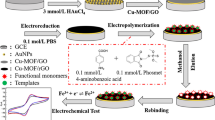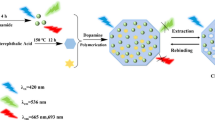Abstract
The sol–gel-derived host matrices are well known for biosensor applications where various types of organic and biological molecules can be immobilized and can act as recognition elements. The molecular imprinting technology is an attractive alternative method where expensive and labile biorecognition elements can be replaced by molecular imprinted polymers (MIPs), which are capable of recognizing a target molecule of an interest. In the present study, hybrid sol–gel MIPs were synthesized in the form of crushed powder (CP) by both non-hydrolytic and hydrolytic method for cholesterol recognition. These MIPs were characterized by scanning electron microscopy (SEM), fourier transform-infrared (FT-IR), liquid chromatography-mass spectrometry (LC–MS) and nitrogen adsorption–desorption isotherm measurements. The template molecule was extracted by means of soxhlet extraction and calcination method. The cholesterol adsorption experiments were performed by using non-imprinted (NI) and extracted crushed powder (ExCP) and the percentage of adsorption was determined by measuring the residual quantity in the analyte solution using Liebermann-Burchard (L-B) reagent. The adsorption studies with non-imprinted crushed powder (NICP) showed interference with L-B reagent as well as non-specific binding between analyte molecules and silica matrix. The percentage of adsorption or rebinding was found to be higher for phenyl triethoxysilane (PhTEOS)-derived ExCP (composition 3) which was synthesized by the aqueous sol–gel processing method at low pH as compared to PhTEOS-derived (composition 1) and 3-aminopropyltriethoxysilane (APTES)-derived ExCP (composition 2) prepared by non-hydrolytic method. The reusability of used ExCP after re-extraction was also investigated. The various factors affecting rebinding of template molecules were discussed along with interference study. The study provided information on molecular imprinting of cholesterol in sol–gel matrix and highlighted the importance of characterization of MIPs before applying it for sensing applications.











Similar content being viewed by others
References
Haupt K (2001) Analyst 126:747
Vlatakis G, Andersson LI, Muller R, Mosbach K (1993) Nature 361:645
Mosbach K (1994) Trends Biochem Sci 19:9
Marx S, Liron Z (2001) Chem Mater 13:3624
Marx S, Zaltsman A (2003) Int J Environ Anal Chem 83:671
Olwill A, Hughes H, O’Riordain M, McLoughlin P (2004) Biosens Bioelectron 20:1045
Han DM, Fang GZ, Yan XP (2005) J Chromatogr A 1100:131
Wei H, Tsai Y, Wu J, Chen H (2006) J Chromatogr B Anal Technol Biomed Life Sci 836:57
Dıaz-Garcıa ME, Badıa Laın R (2005) Microchim Acta 149:19
Chen Z, Ichetovkin M, Kurtz M, Zycband E, Kawka D, Woods J, He X, Plump AS, Hailman E (2010) Lipids Health Dis 9:61
Whitecombe MJ, Rodriguez E, Villar P, Vulfson EN (1995) J Am Chem Soc 117:7105
Hwang C-C, Lee WC (2002) J Chromatogr A 962:69
Spizzirri UG, Peppas NA (2005) Chem Mater 17:6719
Ciardelli G, Borrelli C, Silvestri D, Cristallini C, Barbani N, Giusti P (2006) Biosens Bioelectron 21:2329
Fujiwara M, Nishiyama M, Yamamura I, Ohtsuki S, Nomura R (2004) Anal Chem 76:2374
Soares CMF, Zanin GM, de Moraes FF, dos Santos OAA, de Castro HF (2007) J Incl Phenom Macrocycl Chem 57:79
Hsu C-W, Yang M-C (2008) J Non Cryst Solids 354:4037
Huang TC, Chen CP, Wefler V, Raftery A (1961) Anal Chem 33:1405
Ness AT, Pastewka JV, Peacock AC (1964) Clin Chim Acta 10:229
Yoshinaga I, Yamada N, Katayama S (2003) J Sol Gel Sci Tech 28:65
Gupta R, Chaudhury NK (2007) Biosens Bioelectron 22:2387
Elizabeth A, Joseph C, Ittyachen MA (2001) Bull Mater Sci 24:431
Seethalakshmi Ammal M, George KV, Jayakumari I (2007) Cryst Res Technol 42:876
Kim E, Goldberg M (1969) Clin Chem 15:1171
Daragan VA, Voloshin AM, Chochina SV, Khazanovich TN, Wood WG, Avdulov NA, Mayo KH (2000) Biophys J 79:406
Baluja S, Gajera R, Vekariya N, Bhatt M, Bhalodia R (2009) Arch Appl Sci Res 1:263
Burke R, Diamondstone BI, Velapoldi RA, Menis O (1974) Clin Chem 20:794
Acknowledgments
The present study was supported by grants through Young Scientist Award to Dr. Radha Gupta under SERC-Fast track scheme from Department of Science and Technology (DST), India and the project grant from Council of Scientific and Industrial Research (CSIR), India. Dr. Ashish Gupta, Center for Nanotechnology Initiative and Samtel Center for Display Technologies, IIT- Kanpur is gratefully acknowledged for his help and useful discussions. We would like to thank Prof. Nishith Verma and Dr. Sri Sivakumar, Chemical Engineering, IIT-Kanpur for pore size distribution and fluorescence measurements, respectively.
Author information
Authors and Affiliations
Corresponding author
Rights and permissions
About this article
Cite this article
Gupta, R., Kumar, A. Synthesis and characterization of sol–gel-derived molecular imprinted polymeric materials for cholesterol recognition. J Sol-Gel Sci Technol 58, 182–194 (2011). https://doi.org/10.1007/s10971-010-2376-5
Received:
Accepted:
Published:
Issue Date:
DOI: https://doi.org/10.1007/s10971-010-2376-5




